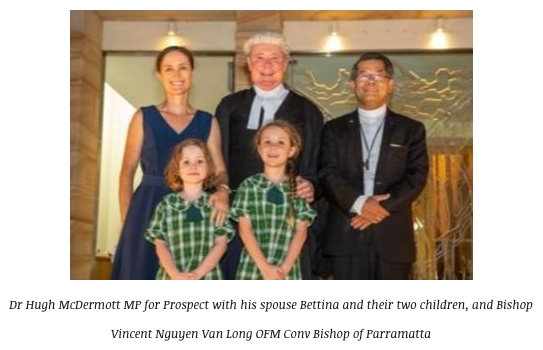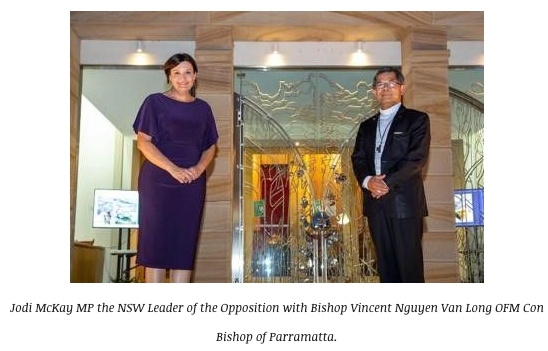
Thank you
Thank you to all who attended either the Red Mass Sydney, or the Red Mass Parramatta. You can watch the Red Mass Sydney on the following link: https://youtu.be/kkAehIDPuho
This was the 90th year the Red Mass has been celebrated in Sydney. We are grateful to Bishop Richard Umbers, Auxiliary Bishop of Sydney, who celebrated the Red Mass Sydney for us.
We are grateful to Fr Don Richardson, the Dean of St Mary’s Cathedral, Jennifer Foo, Special Liturgies Officer, and to Tim Goonan, Events Manager of the Archdiocese for their consistent support. Our former President John McCarthy QC, Emeritus Ambassador to the Vatican, and now Chair of the Sydney Archdiocesan Anti Slavery Taskforce, reminds me that the 100th anniversary of the Red Mass will be celebrated in 2031. That is a year to be looked forward to. It was great to see friends, old and new, at the Red Mass, including Greg Smith SC, former Attorney General for NSW, and former President of the St Thomas More Society. Richard Perrignon, another former President of the Society, and Master of Sacred Music St John’s College within the University of Sydney, conducted the Capella Sublima which has provided the choral accompaniment at the Sydney Red Mass for over 20 years. The Red Mass Sydney would not be possible without Giles Tabuteau, the Society’s Co-ordinator of the Red Mass, without Anthony Herro, the Society’s Secretary, and without Robert Colquhoun, the Society’s Treasurer.
Two Catholic Law Schools
There are two Sydney Catholic Law Schools – Australian Catholic University and Notre Dame. I was pleased to see Dr May Fong Cheong, Acting Deputy Head from the ACU North Sydney Campus. The new Dean, Professor Patrick Keyser, is a victim of COVID restrictions, locked up in Victoria, but we are hoping to see him in Sydney shortly. Amongst the Notre Dame contingent was the Dean Professor Michael Quinlan, Professor Gerard Ryan, Professor Iain Benson, and Adjunct Professor Anna Walsh.
Red Mass Parramatta

The Red Mass Parramatta is in its third year, promoted by the Parramatta Law Society. The Red Mass was celebrated by Bishop Vincent Nguyen Van Long OFM Conv Bishop of Parramatta, with the homily given by Very Rev Fr Peter Williams, Vicar General. Subject to social distancing, the Cathedral was full. The Red Mass Parramatta was attended by Jodi McKay MP, the NSW Leader of the Opposition. Judges and counsel robed in the Cathedral Presbytery, and there was the usual procession. The Parramatta Red Mass reflects the reality that most Sydneysiders live west of Strathfield, and the imperative to move the courts closer to where people live.
Commencement Services
Mark Speakman SC MP, the Attorney-General for NSW, has been a great supporter of the Commencement Services at Church, Synagogue and Mosque – as has been Dr Hugh McDermott MP representing the Shadow Attorney. Each year there are Commencement Services at St James’ King Street, the Greek Orthodox Cathedral of The Annunciation of Our Lady Redfern, St George Coptic Orthodox Church, the Great Synagogue Elizabeth Street, and this year the Lakemba Mosque – as well as at Christ Church Cathedral, Newcastle. The Commencement Services, involving people of many different origins, of many different cultures and religions, are part of modern Australia. The St Thomas More Society publicises each of the Commencement Services as a way of embracing all Australians.
Notre Dame Paris
The Red Mass was first celebrated at Notre Dame Cathedral Paris in 1245. From Paris the Red Mass has spread around the world. So we are part of a very old tradition. The Red Mass tradition derives from a much older tradition of dialogue about law and justice which, in documentary form, commences with the Hebrew Bible, or as Jews of the diaspora, and Christians knew it, the Septuagint. This tradition embraces aspects of the thought of the Athenian philosophers, Socrates, Plato, Aristotle, as well as the Stoics, and the Roman orator, Marcus Tullius Cicero.
Jesus Christ
Central to the tradition is the teaching of Jesus Christ, particularly in the Sermon on the Mount, the Magna Carta of Christian ethics. The centrality of Jesus Christ to the tradition is explained by Pope St John Paul II in his encyclical Veritatis Splendor: the Splendor of Truth (1993). The tradition embraces St Paul who in his Letter to the Romans gives new emphasis to the concept of natural law found amongst the pagan Greeks. Even without the teaching of Christ, without the teaching of the Church, the law of good and evil, right and wrong, is written on our hearts. Our conscience bears witness to this law.
Red Mass Tradition
Here is an understanding of transcendent justice which stresses objectivity, intelligibility, and universality. The idea of transcendent justice is exemplified by Moses who comes down from Mount Sinai with the two stone tablets, on which are inscribed the Ten Commandments. Moses is a figure of Christ who, in the Sermon on the Mount, did not abolish the law, but fulfilled it, brought it to perfection. The tradition embraces aspects of the thought of the Church Fathers, not least St Augustine, whose just war theory provides fuel for debate, even today. The tradition embraces the Corpus Juris Civilis of Justinian, the Byzantine Roman emperor (527-565).
High Middle Ages
The High Middle Ages, when the Red Mass was first celebrated, was a time when the legal systems, which eventually became the legal systems of modern Europe, not least the common law of England, were first developing. In 1273 St Thomas Aquinas ceased writing his Summa Theologiae containing Treatises on Law, on Justice, and on Injustice. There is to be found in the Summa a discussion of the role of courts, judges, lawyers, witnesses, of perennial value. The diverse origins of the tradition are illustrated by the influence on Aquinas, not only of the pagan philosopher Aristotle, but the Islamic philosophers Al-Farabi (872-950), Avicenna (980-1037), and Averroes (1126-29), and of the Jewish philosopher and theologian, Moses Maimonides (1138-1204).
The tradition of dialogue about law and justice has continued in the writings of Richard Hooker, Sir Edward Coke, William Blackstone, Hugo Grotius, John Locke, Immanuel Kant, Montesquieu, the American Founding Fathers, Alexis de Tocqueville, C S Lewis, Jacques Maritain, Lon Fuller, Leo Strauss, Mortimer Adler, Martin Luther King, Karol Wojtyla, and John Finnis.
Reason and Law
While the tradition embraces a dialogue between different thinkers with different emphases, certain themes are typical of the tradition:
- Lawmakers are responsible for their exercise of power;
- Law is an exercise, not merely a will, but of reason;
- Law ought respect the dignity of each and every person, no matter who, but especially the poor and vulnerable, children, the aged, the homeless, the sick and disabled, the imprisoned, the refugee, and those affected by war and natural disaster;
- Law ought respect the human rights of all, but especially those who have least means of enforcing their rights;
- Law ought respect justice not only between persons, but also amongst different groups in the community, and between generations;
- Law ought respect the common good;
- Law ought avoid a legalism which is blind to justice, to equity, to mercy, and a pursuit of money which is indifferent to the human values which are underlie law.
The principle common to many – do unto others as you would have done unto yourself – states our understanding of the law.
Positive Law
The tradition has significant influence on Australian law as illustrated by Geoff Lindsay and Wayne Hudson (eds), Australian Jurists and Christianity, Federation Press, 2021- in particular, in essays on James Stephen, John Hubert Plunkett, Henry Bourne Higgins, Sir Ronald Wilson, Sir Francis Brennan, Sir William Deane, Murray Gleeson. Cases such as Somerset v Stewart (1772) 98 ER 499; Donoghue v Stevenson [1932] AC 562; Tuckiar v R (1934) 52 CLR 335; Brown v Board of Education of Topeka 347 US 483 (1954), reflect this tradition, as does the Universal Declaration of Human Rights (1948).
So, when the Red Mass is celebrated anywhere around the world, we are reminded of an understanding of law and justice directed to the good of each and every person, an understanding of law directed to the common good, an understanding of the rule of law critical to human good. This tradition of the Red Mass speaks to all.
Michael McAuley
